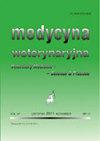Basic haematological and biochemical parameters of farmed red deer and fallow deer blood
IF 0.4
4区 农林科学
Q4 VETERINARY SCIENCES
Medycyna Weterynaryjna-Veterinary Medicine-Science and Practice
Pub Date : 2023-01-01
DOI:10.21521/mw.6775
引用次数: 1
Abstract
Knowing the blood composition and determining the range of reference values for individual species of domestic animals is a key factor in monitoring their individual and herd health. The aim of the study was to determine the values of selected morphological and biochemical blood parameters, and also to compare the results obtained for farm red deer (Cervus elaphus) with fallow deer (Dama dama). Blood haematological parameters were determined using an automatic haematological analyzer with appropriate software, while biochemical parameters were determined using an automatic analyzer using the spectrophotometric method. The values of morphological and biochemical blood parameters of both deer species were close to the reference values of the blood of domestic ruminants. The only significant differences concerned the level of glucose and total cholesterol. Mean glucose levels of 145.90 ± 28.56 g/dl in red deer and 96.31 ± 14.51 g/dl in fallow deer were higher compared to glucose levels in sheep, goats and cattle. In contrast, the cholesterol level of 59.90 ± 3.18 mg/dl and 77.23 ± 13.74 mg/dl, respectively, in of the researched species was significantly lower compared to the reference level for domestic ruminants. To conclude, it can be assumed that these differences in blood composition may result from the species diversity of the tested animals compared to sheep, goats and cattle. In addition, it should be borne in mind that different husbandry procedures are used for these species, including limited interference with their feeding habits, which in this case are closer to the conditions of their natural habitat.养殖马鹿和休闲鹿血液的基本血液学和生化参数
了解单个家畜品种的血液成分和确定参考值范围是监测其个体和畜群健康的关键因素。本研究的目的是确定某些形态和生化血液参数的值,并比较农场马鹿(Cervus elaphus)和休闲鹿(Dama Dama)的结果。血液学参数采用配备相应软件的自动血液学分析仪测定,生化参数采用分光光度法自动分析仪测定。两种鹿的血液形态和生化参数值均接近国内反刍动物血液参考值。唯一显著的差异在于葡萄糖和总胆固醇的水平。与绵羊、山羊和牛相比,马鹿的平均血糖水平为145.90±28.56 g/dl,黇鹿的平均血糖水平为96.31±14.51 g/dl。反刍动物的胆固醇水平分别为59.90±3.18 mg/dl和77.23±13.74 mg/dl,显著低于家兽的参考水平。总之,可以假设这些血液成分的差异可能是由于与绵羊、山羊和牛相比,测试动物的物种多样性造成的。此外,应该记住,对这些物种使用了不同的饲养程序,包括对其摄食习惯的有限干扰,在这种情况下,它们的摄食习惯更接近其自然栖息地的条件。
本文章由计算机程序翻译,如有差异,请以英文原文为准。
求助全文
约1分钟内获得全文
求助全文
来源期刊

Medycyna Weterynaryjna-Veterinary Medicine-Science and Practice
VETERINARY SCIENCES-
CiteScore
0.80
自引率
0.00%
发文量
73
审稿时长
4-8 weeks
期刊介绍:
"Medycyna Weterynaryjna" publishes various types of articles which are grouped in the following editorial categories: reviews, original studies, scientific and professional problems, the history of veterinary medicine, posthumous memoirs, as well as chronicles that briefly relate scientific advances and developments in the veterinary profession and medicine. The most important are the first two categories, which are published with short summaries in English. Moreover, from 2001 the editors of "Medycyna Weterynaryjna", bearing in mind market demands, has also started publishing entire works in English. Since 2008 the periodical has appeared in an electronic version. The following are available in this version: summaries of studies published from 1999 to 2005, full versions of all the studies published in the years 2006-2011 (in pdf files), and full versions of the English studies published in the current year (pdf). Only summaries of the remaining studies from the current year are available. In accordance with the principles accepted by the editors, the full versions of these texts will not be made available until next year.
All articles are evaluated twice by leading Polish scientists and professionals before they are considered for publication. For years now "Medycyna Weterynaryjna" has maintained a high standard thanks to this system. The review articles are actually succinct monographs dealing with specific scientific and professional problems that are based on the most recent findings. Original works have a particular value, since they present research carried out in Polish and international scientific centers.
 求助内容:
求助内容: 应助结果提醒方式:
应助结果提醒方式:


